The flow cytometry market is estimated to be valued at USD 8.35 Bn in 2025 and is expected to reach USD 17.34 Bn by 2032, exhibiting a compound annual growth rate (CAGR) of 11.0% from 2025 to 2032.
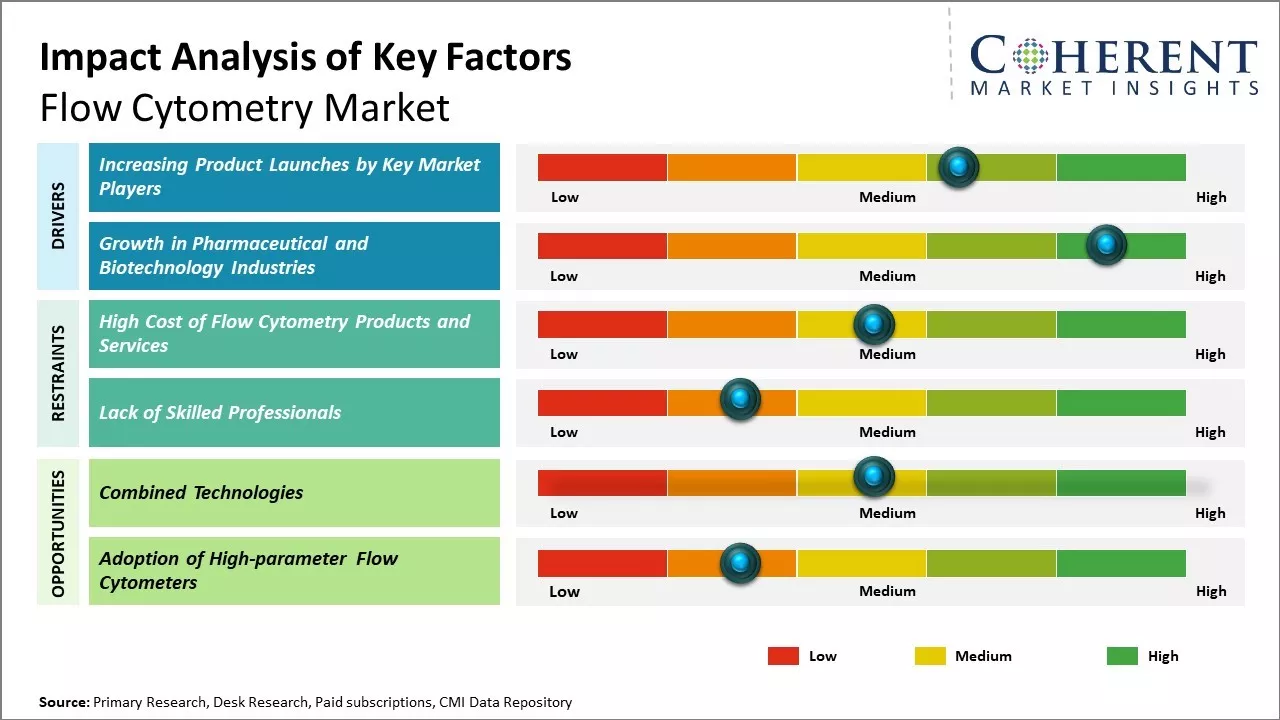
Discover market dynamics shaping the industry: Request sample copy
The flow cytometry market is expected to witness positive growth over the forecast period. This is attributed to increased incidence of chronic diseases such as cancer, diabetes, cardiovascular diseases, and rising investments and funding for research activities related to drug discovery and development. Moreover, technological advancements in flow cytometers such as the development of high-throughput flow cytometry technique which allows screening of large number of cells at a rapid pace positively impacts the market growth. Adoption of flow cytometry techniques for stem cell research, organ transplantation, and immunology and immunotherapy also support market expansion. However, high cost of equipment and stringent regulatory approval process for new devices may impede the market growth to some extent over the forecast period.
Increasing Product Launches by Key Market Players
Increasing adoption of organic strategies such as product launches by key market players is expected to drive the global flow cytometry market growth over the forecast period. For instance, in June 2022, BD, a medical technology company, announced that it had launched an advanced flow cytometry system that sorts cells based on their inner workings. This system will sort and characterize the myriad cells that makes up the human body. It aims to profile individual cells based on their visual characteristics in addition to various protein biomarkers, at a rate of up to 15,000 cells per second.
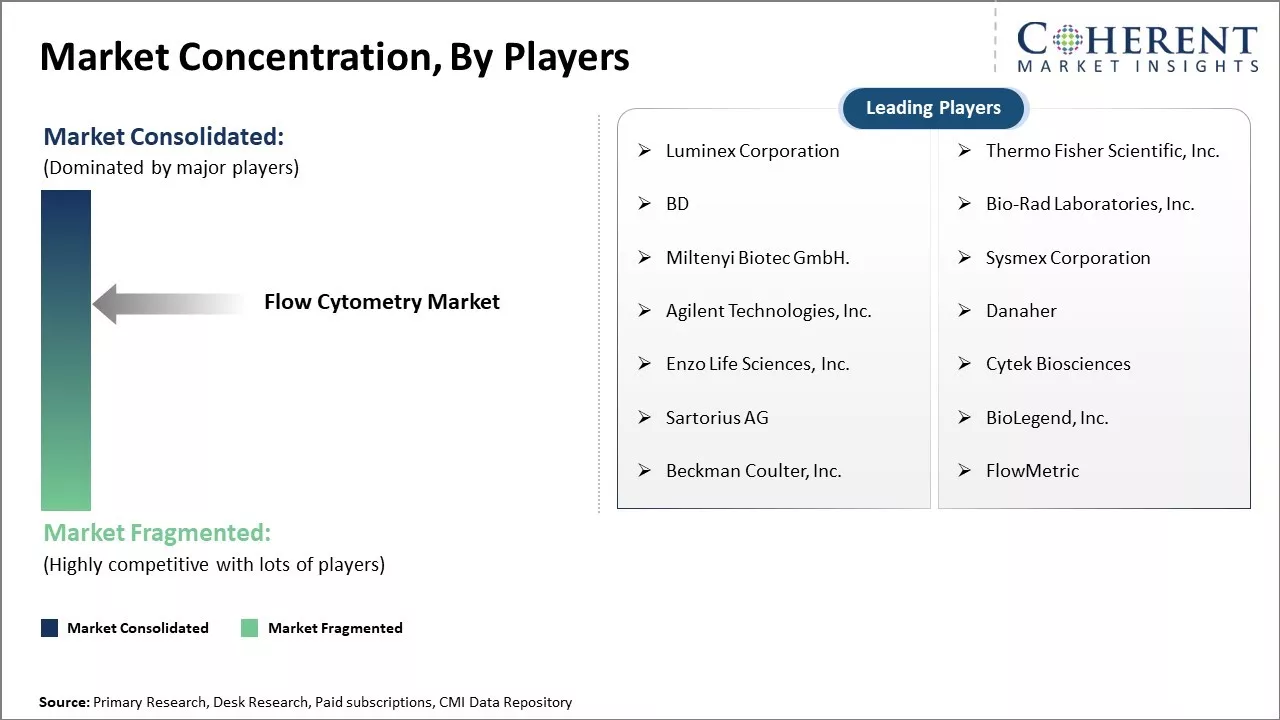
Get actionable strategies to beat competition: Request sample copy
Growth in Pharmaceutical and Biotechnology IndustriesThe expanding pharmaceutical and biotechnology industries around the globe have significantly boosted the adoption of flow cytometry techniques. Flow cytometry finds widespread usage right from the initial drug discovery and development phases to the final validation and quality control tests. Researchers in these industries heavily rely on flow cytometry for detecting rare cell populations, screening novel bioengineering cell lines, developing personalized medicine assays, and others. As pharmaceutical giants are constantly seeking innovative drug candidates and therapies, their R&D expenditures on flow cytometry solutions have risen tremendously over the past decade. The demand has also grown from small biotech startups who are exploring flow cytometry for validating their ideas and attracting funding. With more focus on precision medicine and biomarker-based drug development, the application of flow cytometry is projected to steadily rise in pharmaceutical and biotech companies in the coming years.
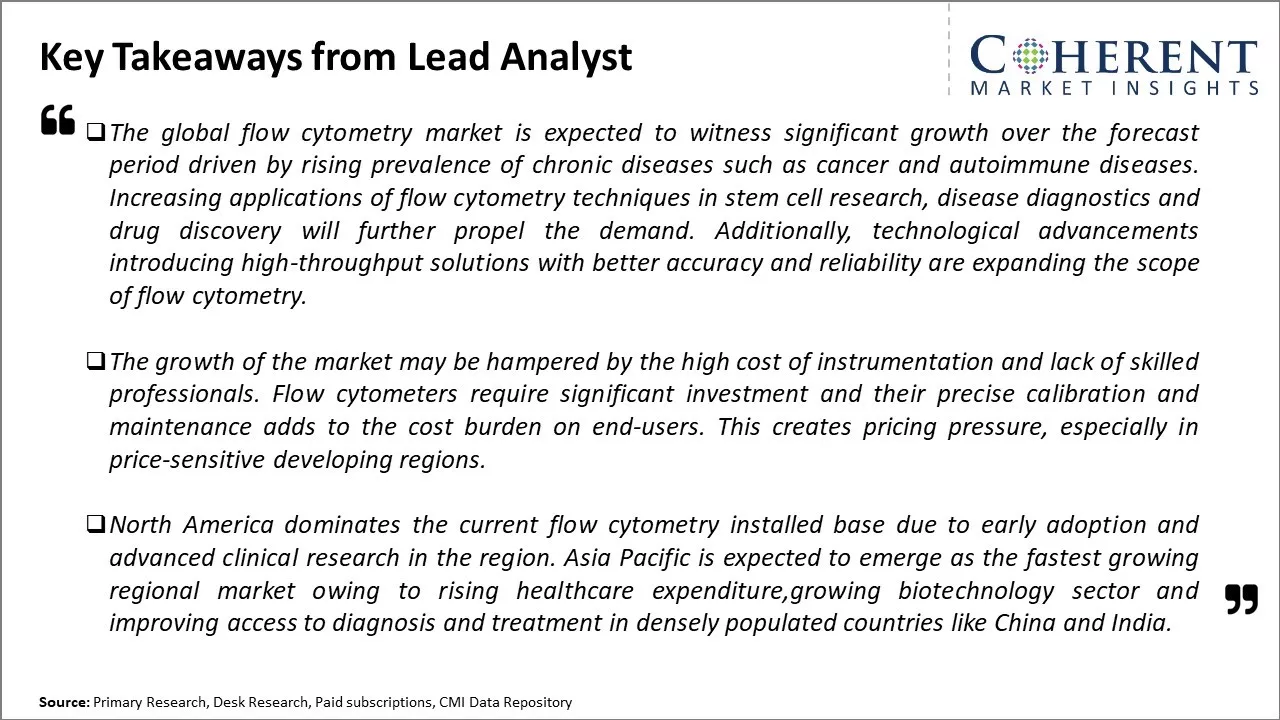
To learn more about this report, Request sample copy
Market Challenges – High Cost of Flow Cytometry Products and ServicesFlow cytometry instruments require a significant capital investment, ranging anywhere from US$ 100,000 to over US$ 500,000 depending on the complexity of the system. Similarly, reagents, antibodies and other consumables used in flow cytometry experiments also have high recurring costs. Setting up a core flow cytometry facility mandates not just the instrument but specialized infrastructure like vibration isolation tables, electricity and gas backups, and trained staff for operation and maintenance, which adds to the overhead costs substantially.
Market Opportunities – Combined Technologies
Combined technologies have the potential to vastly expand applications and use cases for flow cytometry. By integrating analytical capabilities from multiple disciplines, combined approaches allow researchers to gain novel insights from cells and biologics. For example, the integration of cell sorting with genomics offers an unmatched view of cell states and phenotypes. Researchers can isolate specific cell populations based on surface marker expression and other characteristics, then analyze gene expression profiles or genome sequences. This powerful combination reveals how cellular characteristics correlate with genomic patterns on a single-cell level. Technologies that pair flow cytometry with mass spectrometry also show promise, identifying proteins, lipids, and other molecules expressed within sorted populations.
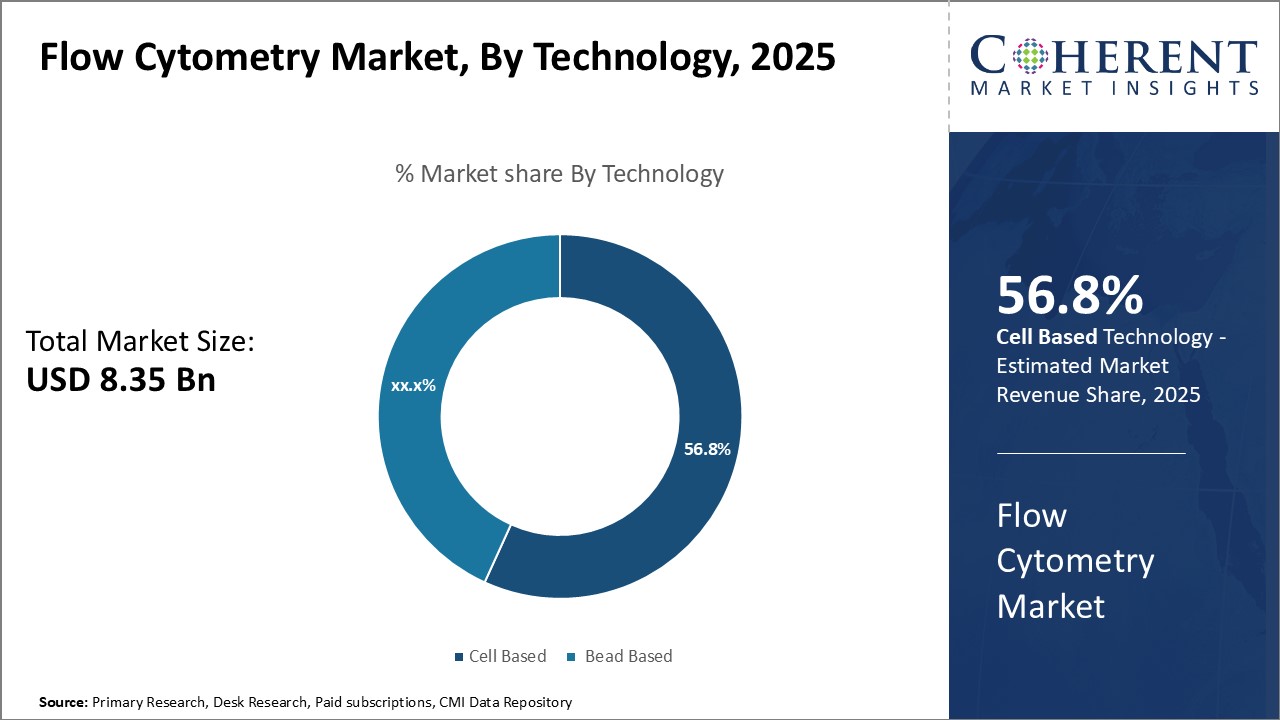
Discover high revenue pocket segments and roadmap to it: Request sample copy
Insights, By Technology: Superior Immunophenotyping Capabilities Drive the Dominance of Cell Based TechnologyThe technology segment includes cell based and bead based. The cell based sub-segment is estimated to hold 56.8% of the market share in 2025 which is mainly attributable to cell-based flow cytometry instruments' superior ability to perform immunophenotyping analysis as compared to bead-based instruments. Immunophenotyping, which is the analysis of the presence or absence of cellular markers on cells, is one of the most common applications of flow cytometry. Cell based flow cytometry allows for highly multiparametric immunophenotyping through the detection of up to 20 different cellular markers on single cells simultaneously. This high level of multiplexing capability aids in the comprehensive characterization and analysis of complex cell populations.
Insights, By Product Type: Higher Throughput and Automation Capabilities
The product type segment includes analyzer, sorter, research, and reagent & consumables. The analyzer sub-segment is estimated to hold 38.9% of the market share in 2025 owing to advantages in sample handling throughput and automation. Flow cytometers have evolved significantly from basic analyzers to fully automated high-throughput analyzers suited for large volume clinical and research screening. Advanced analyzers are integrated with robotics and liquid handling systems, which enhance workflow efficiency. Analyzers can simultaneously acquire signals from thousands of cells per second, allowing for rapid processing of samples. Their high-speed multi-laser optical setups combined with automatic sampling systems minimize user intervention. This high degree of walkaway automation streamlines complex multiparameter assays and reduces operator errors. Analyzers are thus well-equipped to fulfill increasing throughput demands from applications analyzing large patient cohorts and cell populations.
Insights, By End User: Superior Diagnostic Capabilities Drive the Hospitals Segment Growth
The end user segment includes hospitals, clinical testing laboratories, and research laboratories. The hospitals sub-segment is estimated to hold 38.9% of the market share in 2025 due to flow cytometry being an integral tool for diagnostic applications across various clinical specialties. Immunophenotyping performed by flow cytometers aids in the identification and characterization of hematological malignancies including leukemias and lymphomas. It enables the classification of these cancers into prognostic subgroups by detecting expression patterns of cellular markers. Additionally, flow cytometry assessments are routinely used in stem cell transplantation procedures for stem cell quantitation and selection. Hospitals also utilize flow cytometric assays for immune monitoring in diagnostic areas like human immunodeficiency virus disease (HIV/AIDS). Advanced flow cytometers in hospitals provide comprehensive immunophenotyping capabilities for definitive diagnosis of these conditions based on precise phenotypic characterizations.
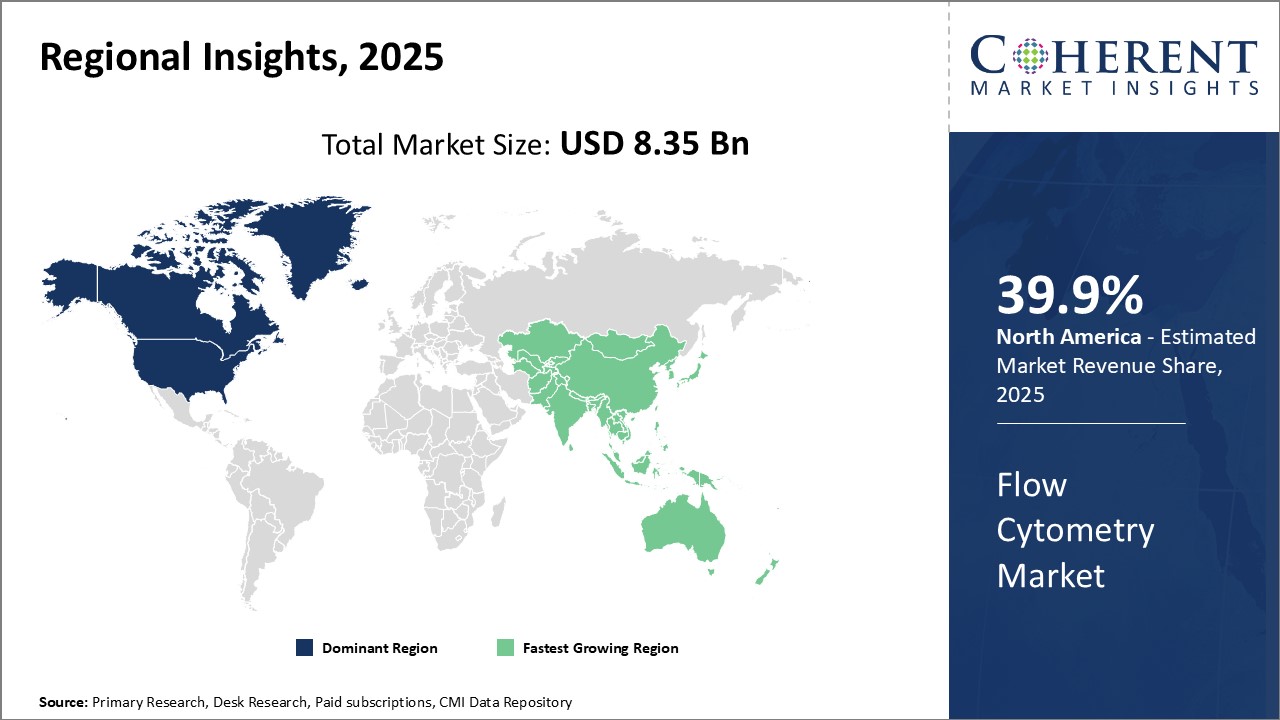
Need a Different Region or Segment? Customize now
North America remains the dominant region in the global flow cytometry market and is estimated to hold 39.9% of the market share in 2025. This can be attributed to strong healthcare infrastructure and government funding for research activities in countries like the U.S. Several top pharmaceutical and biotech companies are based in North America, driving extensive R&D initiatives that adopt flow cytometry solutions. The advanced science industries in the region also favor technological advancements, leading to higher adoption of new flow cytometers, reagents, and software. Along with a sophisticated customer base, this makes North America an attractive production and marketing hub for all major flow cytometry vendors.
The Asia Pacific region has emerged as the fastest growing market for flow cytometry in recent years. With improving healthcare systems and rising medical expenditures, many countries in Asia Pacific are prioritizing biomedical sciences and biomanufacturing. This has opened up new opportunities for flow cytometry. The presence of a large patient pool and low-cost operations make Asia Pacific an appealing destination for global pharmaceutical companies to conduct clinical trials and carry out R&D activities. These applications require extensive flow cytometry services, driving demand. Export-oriented policies of nations like China and India have also seen growing shipments of flow cytometers, reagents, and accessories to cater to clients worldwide. The Asia Pacific market benefits from the rapid expansion of life sciences industries as well as increasing healthcare access and investments across Asia Pacific . Rapid urbanization, growing medical tourism, and rising disposable incomes in the region are additional factors complementing the fast growth trajectory.
Flow Cytometry Market Report Coverage
| Report Coverage | Details | ||
|---|---|---|---|
| Base Year: | 2024 | Market Size in 2025: | USD 8.35 Bn |
| Historical Data for: | 2020 To 2024 | Forecast Period: | 2025 To 2032 |
| Forecast Period 2025 to 2032 CAGR: | 11.0% | 2032 Value Projection: | USD 17.34 Bn |
| Geographies covered: |
|
||
| Segments covered: |
|
||
| Companies covered: |
Luminex Corporation, Thermo Fisher Scientific, Inc., BD, Bio-Rad Laboratories, Inc., Miltenyi Biotec GmbH., Sysmex Corporation, Agilent Technologies, Inc., Danaher, Enzo Life Sciences, Inc., Cytek Biosciences, Sartorius AG, BioLegend, Inc., Beckman Coulter, Inc., and FlowMetric |
||
| Growth Drivers: |
|
||
| Restraints & Challenges: |
|
||
Uncover macros and micros vetted on 75+ parameters: Get instant access to report
*Definition: Flow cytometry is a laser-based technique which is used to detect and analyze chemical or physical characteristics of cells or particles, which is most commonly used to evaluate bone marrow, peripheral blood, and other fluids in the body. Flow cytometry is continuously going through new developments with availability of robust photo detectors and new laser emitters, use of LED lamps as emitter, and changes in analytical capacity (multidimensional analysis software).
Share
Share
About Author
Abhijeet Kale is a results-driven management consultant with five years of specialized experience in the biotech and clinical diagnostics sectors. With a strong background in scientific research and business strategy, Abhijeet helps organizations identify potential revenue pockets, and in turn helping clients with market entry strategies. He assists clients in developing robust strategies for navigating FDA and EMA requirements.
Missing comfort of reading report in your local language? Find your preferred language :
Transform your Strategy with Exclusive Trending Reports :
Frequently Asked Questions
Joining thousands of companies around the world committed to making the Excellent Business Solutions.
View All Our Clients
US Reciprocal Tax Impact Analysis On Flow Cytometry Market
Stay updated on tariff changes with expert insights and timely information